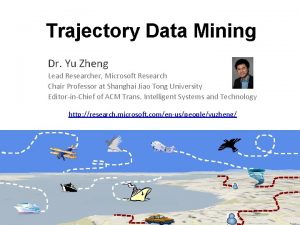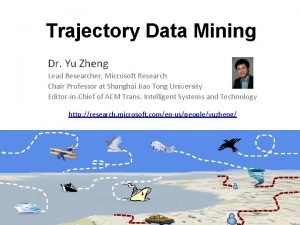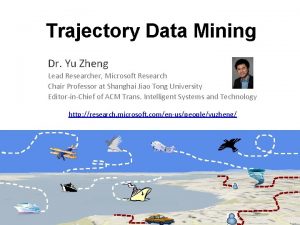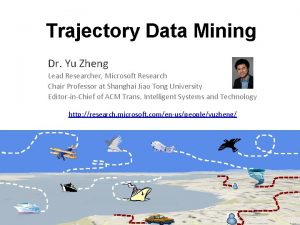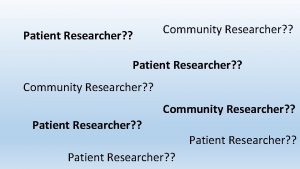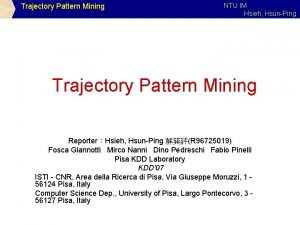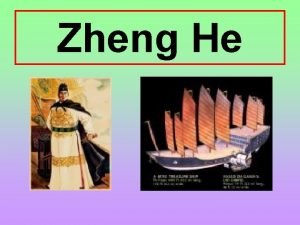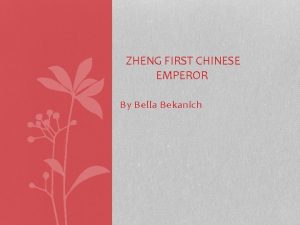Trajectory Data Mining Dr Yu Zheng Lead Researcher


















- Slides: 18

Trajectory Data Mining Dr. Yu Zheng Lead Researcher, Microsoft Research Chair Professor at Shanghai Jiao Tong University Editor-in-Chief of ACM Trans. Intelligent Systems and Technology http: //research. microsoft. com/en-us/people/yuzheng/

Paradigm of Trajectory Data Mining Yu Zheng. Trajectory Data Mining: An Overview. ACM Transactions on Intelligent Systems and Technology. 2015, vol. 6, issue 3.

Trajectory Classification • Differentiate between trajectories (or its segments) of different status: – – motions transportation modes human activities …… • Applications – – trip recommendation life experiences sharing context-aware computing ……

Trajectory Classification • General Steps: – Divide a trajectory into segments using segmentation methods. Sometimes, each single point is regarded as a minimum inference unit – Extract features from each segment (or point) – Build a model to classify each segment (or point) • Some models – Dynamic Bayesian Network (DBN) – HMM and Conditional Random Field (CRF)

Learning Transportation Modes Based on GPS Trajectories • Goal & Results: Inferring transportation modes from raw GPS data – Differentiate driving, riding a bike, taking a bus and walking – Achieve a 0. 75 inference accuracy (independent of other sensor data) GPS log Infer model

Learning Transportation Modes Based on GPS Trajectories • Motivation – For users: • Reflect on past events and understand their own life pattern • Obtain more reference knowledge from others’ experiences – For service provider: • Classify trajectories of different transportation modes • Enable smart-route design and recommendation • Difficulty – Velocity-based method cannot handle this problem well (<0. 5 accuracy) – People usually transfer their transportation modes in a trip – The observation of a mode is vulnerable to traffic condition and weather Yu Zheng, et al. Understanding Mobility Based on GPS Data. Ubi. Comp 2008


Learning Transportation Modes Based on GPS Trajectories • Contributions and insights – A change point-based segmentation method • Walk is a transition between different transportation modes • Handle congestions to some extent – A set of sophisticated features • Robust to traffic condition • Feed into a supervise learning-based inference model – A graph-based post-processing • Considering typical user behavior • Employing location constrains of the real world • WWW 2008 (first version) Yu Zheng, et al. Understanding Mobility Based on GPS Data. Ubi. Comp 2008

Architecture

Walk-Based Segmentation • Commonsense knowledge from the real world – Typically, people need to walk before transferring transportation modes – Typically, people need to stop and then go when transferring modes Yu Zheng, et al. Understanding Mobility Based on GPS Data. Ubi. Comp 2008

Walk-Based Segmentation • Change point-based Segmentation Algorithm – – Step 1: distinguish all possible Walk Points, non-Walk Points. Step 2: merge short segment composed by consecutive Walk Points or non-Walk points Step 3: merge consecutive Uncertain Segment to non-Walk Segment. Step 4: end point of each Walk Segment are potential change points

Feature Extraction (1) • Features Category Features Basic Features Significance Distance of a segment Max. Vi The ith maximal velocity of a segment Max. Ai The ith maximal acceleration of a segment AV Average velocity of a segment EV Expectation of velocity of GPS points in a segment DV HCR Variance of velocity of GPS points in a segment Heading Change Rate Advanced SR Features VCR Stop Rate Velocity Change Rate Yu Zheng, et al. Understanding Mobility Based on GPS Data. Ubi. Comp 2008

Feature Extraction (2) • Our features are more discriminative than velocity – Heading Change Rate (HCR) – Stop Rate (SR) – Velocity change rate (VCR) – >65 accuracy

Graph-Based Post-Processing (1) • Using location-constraints to improve the inference performance? ? Yu Zheng, et al. Understanding Mobility Based on GPS Data. Ubi. Comp 2008

Graph-Based Post-Processing (2) • Transition probability between different transportation modes – P(Bike|Walk) and P(Bike|Driving) Segment[i]. P(Bike) = Segment[i]. P(Bike) * P(Bike|Car) Segment[i]. P(Walk) = Segment[i]. P(Walk) * P(Walk|Car)

Graph-Based Post-Processing (3) • Mine a implied road network from users’ GPS logs – Use the location constraints and typical user behaviors as probabilistic cues – Being independent of the map information Yu Zheng, et al. Understanding Mobility Based on GPS Data. Ubi. Comp 2008

Graph-Based Post-Processing (4) Yu Zheng, et al. Understanding Mobility Based on GPS Data. Ubi. Comp 2008

Thanks! Yu Zheng yuzheng@microsoft. com Homepage Yu Zheng. Trajectory Data Mining: An Overview. ACM Transactions on Intelligent Systems and Technology. 2015, vol. 6, issue 3.
 Trajectory data mining an overview
Trajectory data mining an overview Mining complex types of data in data mining
Mining complex types of data in data mining Mining multimedia databases
Mining multimedia databases Strip mining vs open pit mining
Strip mining vs open pit mining Chapter 13 mineral resources and mining worksheet answers
Chapter 13 mineral resources and mining worksheet answers Difference between strip mining and open pit mining
Difference between strip mining and open pit mining Difference between text mining and web mining
Difference between text mining and web mining Data reduction in data mining
Data reduction in data mining What is data mining and data warehousing
What is data mining and data warehousing What is missing data in data mining
What is missing data in data mining Concept hierarchy generation for nominal data
Concept hierarchy generation for nominal data Data reduction in data mining
Data reduction in data mining Data reduction in data mining
Data reduction in data mining Data cube technology in data mining
Data cube technology in data mining Data reduction in data mining
Data reduction in data mining Arsitektur data mining
Arsitektur data mining Perbedaan data warehouse dan data mining
Perbedaan data warehouse dan data mining Data warehousing and data mining in crm
Data warehousing and data mining in crm Multidimensional analysis and descriptive mining of complex
Multidimensional analysis and descriptive mining of complex
